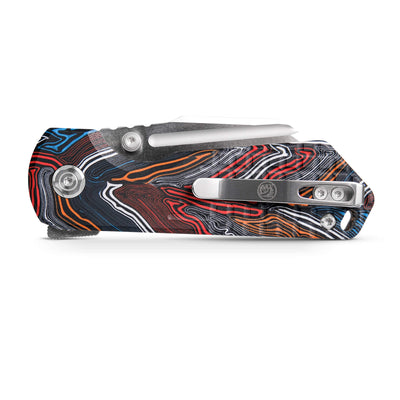Unlock the Secrets: Choosing the Perfect Fixed Blade Knife for Your Needs!
Fixed blade knives have become essential tools for outdoor enthusiasts, survivalists, and everyday users alike. Their sturdy design and reliable performance make them a top choice for a variety of tasks, from preparing food and carving wood to self-defense and survival situations. Unlike their folding counterparts, fixed blade knives feature a blade that extends straight from the handle, providing unmatched strength and ease of use. As more people engage in activities like camping, hiking, and bushcrafting, the interest in fixed blade knives continues to grow. Whether you're a seasoned adventurer or a novice looking to equip yourself for your next trip, understanding the value of a fixed blade knife can significantly enhance your outdoor experience.

Understanding Fixed Blade Knives
A fixed blade knife is characterized by a blade that is fixed in place and does not fold into the handle. This design offers a higher degree of strength and stability, making these knives ideal for heavy-duty tasks. One of the distinguishing features of fixed blade knives is their full tang construction, where the blade extends the full length of the handle, providing better balance and control. In contrast, folding knives have blades that can be tucked away into the handle, making them more portable but generally less robust. The choice between a fixed blade and a folding knife often comes down to the intended use; for tasks that demand durability and strength, fixed blade knives are the clear winner.
Factors to Consider When Choosing a Fixed Blade Knife
When selecting a fixed blade knife, several crucial factors must be taken into account to ensure you choose the right tool for your needs. Each aspect, from blade material to handle type, affects the knife's performance and suitability for specific tasks. Understanding these factors will not only help you make an informed decision but also enhance your overall experience with the knife.
Blade Material
The material of the blade significantly influences its performance and longevity. Common options include stainless steel and carbon steel. Stainless steel is known for its resistance to rust and corrosion, making it a great choice for outdoor use. However, it may not hold an edge as long as carbon steel, which is favored for its sharpness and ease of sharpening. On the other hand, carbon steel requires more maintenance to prevent rust but offers superior cutting performance. When choosing a blade material, consider the environment in which you will use the knife and your willingness to maintain it.
Blade Length
Blade length is another critical factor that affects usability. Shorter blades, typically around 3-4 inches, are ideal for detailed tasks like carving and skinning, while longer blades, ranging from 5-7 inches, excel in chopping and heavier tasks. It's essential to consider what tasks you will be performing most often. A longer blade may offer more versatility, but it can also be cumbersome for intricate work. Finding the right balance based on your intended use is key to maximizing the effectiveness of your fixed blade knife.
Handle Type
The handle of a fixed blade knife can significantly impact comfort and grip. Handles are made from various materials, including wood, synthetic composites, and rubber. Each material offers different levels of comfort, durability, and grip. A good handle should feel comfortable in your hand and provide a secure grip, especially during prolonged use. Ergonomic designs that fit the natural contours of your hand can help prevent fatigue and improve control, making them ideal for extended outdoor activities.
Weight and Balance
The weight and balance of a fixed blade knife are vital for its performance, particularly for tasks that require precision or prolonged use. A well-balanced knife allows for better control and reduces the strain on your wrist. Heavier knives may be better suited for chopping tasks, while lighter knives are often preferred for detailed work. Testing the knife in hand can help you assess its weight distribution and balance, ensuring that it feels comfortable and manageable during use.
Different Types of Fixed Blade Knives
Fixed blade knives come in various categories, each designed for specific uses. Hunting knives are streamlined for skinning and processing game, featuring a sharp edge and a comfortable grip. Survival knives are versatile tools that may include additional features like serrated edges or built-in fire starters, making them essential for emergency situations. Tactical knives are designed for military or self-defense purposes, often featuring robust materials and a sturdy design. Understanding the differences between these types of knives will help you identify which is best suited for your individual needs.
Where to Purchase a Fixed Blade Knife
When it comes to purchasing a fixed blade knife, you have several options. Local retailers often provide the advantage of hands-on inspection, allowing you to feel the knife and assess its weight and balance before buying. Online platforms offer a broader selection and the convenience of shopping from home, but you miss out on the tactile experience. Specialized knife shops, while less common, can provide expert advice and a carefully curated selection of knives tailored to various needs. Each purchasing option has its pros and cons, so consider what matters most to you—whether it's availability, expertise, or the ability to physically test the knife before buying.
Key Takeaways for Selecting the Ideal Fixed Blade Knife
Choosing the right fixed blade knife is a decision that can significantly impact your outdoor experiences and everyday tasks. By understanding the key factors such as blade material, length, handle type, and overall balance, you can make an informed choice that suits your specific needs. With the growing interest in outdoor activities, investing in a quality fixed blade knife not only enhances your skill set but also ensures you are prepared for any situation. Take the time to assess your requirements and explore the various options available, and you'll be well on your way to finding the perfect fixed blade knife for your adventures.







commentaires